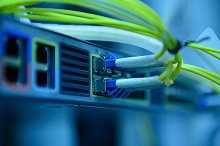Self-provisioning internet can save districts big on monthly costs. So why haven’t more districts invested in it?
 In Evan Marwell’s estimation, anywhere from 10 to 15 percent of the nation’s K-12 school districts have self-provisioned their own fiber networks. In most cases, this CEO of San Francisco-based EducationSuperHighway says these districts opt to self-provision those networks because they can’t get internet access any other way.
In Evan Marwell’s estimation, anywhere from 10 to 15 percent of the nation’s K-12 school districts have self-provisioned their own fiber networks. In most cases, this CEO of San Francisco-based EducationSuperHighway says these districts opt to self-provision those networks because they can’t get internet access any other way.
“These are primarily rural schools that can’t get anyone else to bring cyber to them,” says Marwell, “and/or that couldn’t get a service provider to build a fiber network for them.”
Marwell says there are two major components that are needed to gain internet access: the access itself (i.e., the type that comes into either the district office or some other signal point within the district) and wide-area network (WAN) that connects that district office to all of the schools.
According to Marwell, self-provisioning is usually only involved with the latter, with the primary driver being the ability to effectively run “your own little network that connects all of your schools together,” he explains. “It costs almost nothing to do this, and you can get as much capacity as you need.”
Next page: Potential cost-savings in real numbers
Shaving the Costs
In an effort to save on the cost of self-provisioning, Marwell says schools opt to self-provision only the connection that runs from their district office and out to the service provider. That provider then handles the internet access itself (versus the WAN, which is handled by the school).
And while most schools use self-provisioning because “no one else will build them a fiber network,” says Marwell, taking this step also gives districts some control over their own destinies in terms of capacity. “When you build your own fiber network, and once the fiber is in place, upgrading the capacity of that network is incredibly cheap.” The district that wants a 100MB network connecting its schools, for example, can purchase the necessary optical components for less than $100. The same components for a 1GB network would cost $300-$400, while 10GB would be somewhere between $1,000 and $1,500.
“Upgrading the optical components and upping the network’s capacity is incredibly cheap,” says Marwell. “All of the money goes into the actual building of the fiber, so when you self-provision you gain a lot of control and [scalability] for a small amount of money.”
Putting those costs into perspective, Marwell says that a 1GB WAN circuit that’s run by an outside service provider fetches a national average of about $1,200 per month, while a 10GB circuit is about $4,000 per month. “You can see that you’d be much better off spending a couple of thousand of dollars one time [for the actual self-provisioning work] and getting from 1-10GB,” says Marwell, who estimates that ongoing maintenance costs for a self-provisioned network average $100 to $200 per month, “than paying thousands per month to a service provider.”
Next page: Why more districts will be considering it now
What’s the Holdup?
So the question is, why aren’t more K-12 districts and/or schools rolling up their sleeves and getting into the self-provisioned Internet business? Funding has been the primary obstacle up until now, says Marwell. “Most of them couldn’t afford to built the fiber,” he says. “Mostly it’s the wealthier school districts that have undertaken these projects, namely because the fiber networks themselves are expensive to build. Average national costs for such projects are around $50,000-per-mile, according to Marwell.
“If you consider the district with even just 10 schools–each of which are about 1.5 miles apart –you’re talking about a $750,000 project, give or take,” Marwell explains. “That’s not an easy number of schools to come up with.” In 2015, however, that figure could be within reach for a greater number of schools thanks to recent changes in the FCC’s E-Rate program. “Now when schools can demonstrate that self-provisioning is the most cost-effective option for getting a fiber connection to every school,” says Marwell, “they’ll be able to get their ‘normal’ E-Rate discounts for the [projects].”
The district that has a 70 percent E-Rate discount, for example, would only have to shell out $225,000 for its 10 schools that are 1.5 miles apart from one another. “That represents a massive change in the economics right there,” says Marwell.
Financial constraints aside, some schools just aren’t interested in laying down new fiber in an area where service providers are already present and offering affable pricing for the access. “Many schools just don’t want to have another technical issue to worry about,” says Marwell. “Frankly, if your service provider is charging you a reasonable price ($750-$1,000 per month, depending on capacity), we don’t recommend you go out and try to build a network anyway.”
A Bigger Bargaining Chip
With the revised E-Rate funding plan now including self-provisioning as an option, expect to see more schools considering this choice. In the beginning, Marwell anticipates geographically isolated districts to be among the first to take advantage of the new option, although he’s also seeing signs of interest from other schools as well.
“Going forward, we’ll see more sophisticated districts asking for proposals from service providers while at the same time going out and calculating what it will cost to self-provision,” says Marwell. “That, in turn, will become a price-cap regulator and a bargaining chip for the districts when working with service providers.”
Bridget McCrea is a contributing writer for eSchool News.
- TC- What student choice and agency actually looks like - November 15, 2016
- What student choice and agency actually looks like - November 14, 2016
- App of the Week: Science sensor meets your smartphone - November 14, 2016

